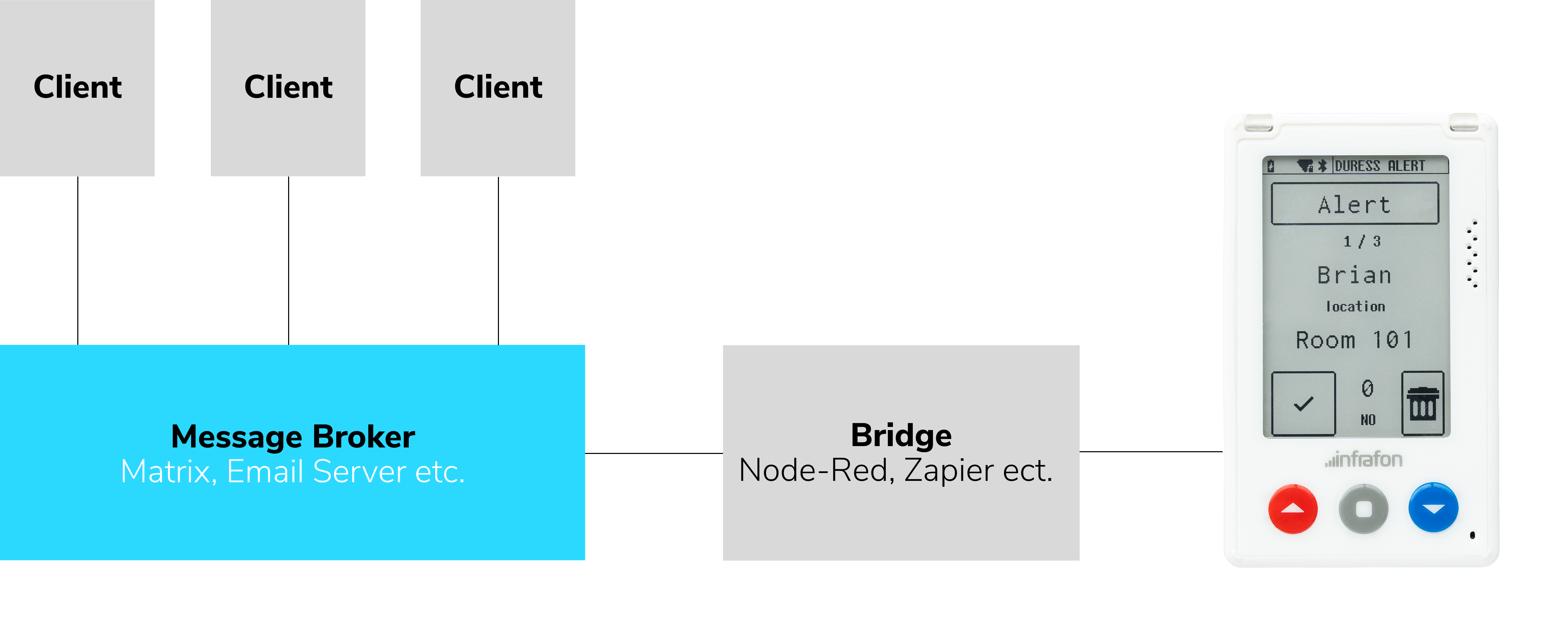The functionality possible with our smart badge is only limited by your imagination. Well maybe not quite literally but there is a lot you can do by combining the different functions with an UI in a workflow editor.
Messages are one of the most essential topics when it comes to communication devices. Creating an alert, receiving a E-mail, getting a text from a colleauge: It's all messages. Therfore we came up with the message-list-dataview:

The message-list-dataview acts like a general message client for the CC2. It takes a single object or an array with the content, sender, subject, id etc. and renders the folders, overview and message page. The layouts are customizable to a point.
Instead of running the messenger client directly on the CC2, we want to use some middleware, that connects to the messenger server to transform and distribute messages to the message-list-dataview.

For using Email on the CC2 we are using again the message-list-dataview, which already comes with a folder structure e.g. for different Inboxes.

The message-list-dataview acts like a general message client for the CC2. It takes a single object or an array with the content, sender, subject, id etc. and renders the folders, overview and message page. The layouts are customizable to a point.
Instead of running the mail client directly on the CC2, we want to use some middleware, that connects to the server to transform and distribute Mails to and from the message-list-dataview.

For this simple demonstration we will not worry about different devices and users but hardcode one E-mail account to a device. So all the Node-Red bridge essentially needs to do is:
- transform/format the incoming message into the required format
- transform non ASCI symbols and images/links

Using the Email node plugin, we can easily connect to the imap & smpt server of our provider. All left to do is store the Email IDs and transform the content into a ASCI only format fitting for the Message-List


With the CC2 smart badge you can emulate different smart cards. Opposite to a smart card, in a case of lost or stolen cards or when you want to allow temporary access, credentials created by the secret on the secure element can be turned on and off from the backend. Using MQTT commands and a very simple UI we are going to demo this using the NXP Desfire2 protocol.
For this very simple case, we will use the node-red UI to create two buttons: Grant access sends the command to enable the credential, deny access disables it.


This is of course the most simplistic execution, this demo could be enhanced by creating a feedback UI on the device and e.g. a requesting mechanism.
With the CC2 smart badge you can emulate different smart cards. Opposite to a smart card, in a case of lost or stolen cards or when you want to allow temporary access, credentials created by the secret on the secure element can be turned on and off from the backend. Using MQTT commands and a very simple UI we are going to demo this using the NXP Desfire2 protocol.
For this very simple case, we will use the node-red UI to create two buttons: Grant access sends the command to enable the credential, deny access disables it.


This is of course the most simplistic execution, this demo could be enhanced by creating a feedback UI on the device and e.g. a requesting mechanism.
The Duress App is a fully functional application that registers user created alarms and informs (based on admin edited rules) other users of this event, which then can acknowledge or ignore that message.
The application records all user actions and stores them in log files.
The Duress Application is in comparison with the other demo cases not a rapid prototype but a self contained application running its one backend & database instance. It is connected to the IES and uses the APIs to fetch device data from the correct entity and for communication it is utilizing the MQTT server.

To get a (at least primitive) localization we can either connect a system like quppaa or another BLE/WiFi based localization engine or simply put in a table with ibeacon MAC adresses linked to room IDs. For User verification we can also connect an external database or a active directory.
The Medication App is a complete application focused on helping nurses and physicians to access medication requirements and to document it after administartion, so that admins have access to those logs.
This App is functional and quite extensive. Users can be added and allocated to devices, beacons can be created and linked to the patient with a prescription schedule. The application then creates an extensive log, that can be searched and filtered.

Users can be linked to devices, which then get updated(OTA) with the right Dataview and configuration using the IES (Allocation). Admins can also configure a set of ibeacons linked to a patient

Devices are taken from the IES and can then be allocated to a user.

Beacons can just be added with a MAC address and then linked to a patient with a medication schedule.

A complete log can be filtered and searched.